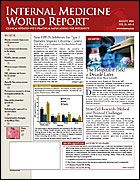Publication
Article
Internal Medicine World Report
New Treatments for Urinary Incontinence on the Horizon
Author(s):
From the American Geriatrics Society
CHICAGO—Physicians may soon be able to offer new treatment options to their patients with urinary incontinence, a noted researcher in the field reported at the annual meeting of the American Geriatrics Society.
Catherine E. DuBeau, MD, associate professor of medicine, University of Chicago, pointed out how common urinary incontinence is in older adults, affecting 30% to 50% of women and 17% of men aged >60 years. Primary care physicians evaluating a patient with urinary incontinence must first determine if the patient is suffering from stress incontinence, urge incontinence, or mixed incontinence, because treatment differs by type.
Dr DuBeau explained that Jeannette Brown, MD, director of the Women’s Continence Center at the University of California, San Francisco, has developed a short questionnaire to help physicians differentiate between incontinence types in women. “It’s a potentially useful thing for primary care physicians, especially to separate out those who may do better with a quicker surgical referral for stress incontinence,” explained Dr DuBeau. “On the urge [incontinence] side, behavior and pharmacotherapy remain the mainstay.”
Although pharmacotherapy for urge incontinence remains popular, potential side effects are receiving increasing attention. “One of the areas getting a lot of noise right now is the cognitive effects of these drugs,” said Dr DuBeau. While comparative trials of oxybutynin (Ditropan) and tolterodine (Detrol, Detrol LA) reveal similar efficacies, “the real differences come in dosing issues and side effects,” she noted.
Most of the drugs are taken once daily, except for trospium (Sanctura). All can cause dry mouth, and some can cause constipation. The availability of many antimuscarinic drugs allows “physicians to pick and choose to tailor the therapy,” she said. But while millions of patients take antimuscarinic agents for incontinence treatment, this class of drugs does have drawbacks. “The efficacy is modest, and the dry mouth is a real drag,” said Dr DuBeau. “What we are all waiting for is new classes of medications.”
One option that has been investigated is botulinum toxin type A (Botox) for the treatment for urge incontinence. “The trials are under way. It gives us another option for people who don’t respond to behavioral therapy,” said Dr DuBeau.
New England Journal of Medicine
One recent study published in the (2006;354: 1557-1566) that was led by Linda Brubaker, MD, of Loyola University Medical Center, Maywood, Ill, evaluated 322 women who were undergoing abdominal sacrocolpopexy for pelvic-organ prolapse. Results showed that women who received concomitant Burch colposuspension in addition to sacrocolpopexy had a significantly lower incidence of bothersome symptoms of stress incontinence compared with women who underwent sacrocolpopexy alone (24.5% vs 6.1%), a finding that could be useful to women facing surgical treatment for prolapse.
Diabetes Care
Although surgery remains the best treatment for stress incontinence, lifestyle measures may help reduce symptoms. A recent study published in (2006;29:385-390) led by Jeannette Brown, MD, of George Washington University, Rockville, Md, determined that weight loss improves stress incontinence in overweight women who are also at risk for diabetes.
Other options are also being investigated. Many men develop incontinence after prostatectomy for prostate cancer, Dr DuBeau said, particularly after radical prostatectomy. Until recently, insertion of an artificial sphincter, which requires major surgery, was the only available treatment. Researchers are now investigating the sling, a less invasive surgical procedure. Results of biofeedback treatment before and after surgery also seem encouraging.
Other researchers are exploring new treatments for incontinence in men and women that focus on the central nervous system rather than on the bladder. The urothelium is neurologically rich tissue, and ongoing research could discover unique mechanisms.
“People are starting to do very interesting functional magnetic resonance imaging studies, which are leading to a better understanding of where in the brain [incontinence] is happening,” Dr DuBeau said. This research could return the focus to the brain and lead to novel methods of incontinence treatment.






